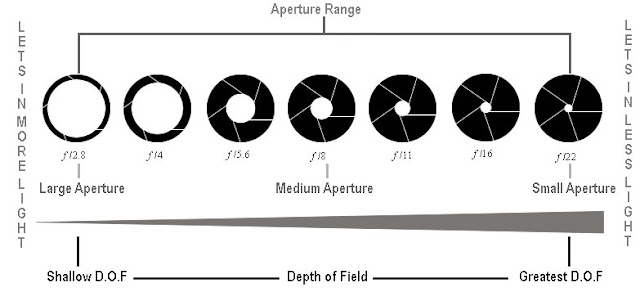Aperture
Aperture controls the amount of light entering the lens and also the depth of field in your camera. A small aperture allows more light to enter the lens and creates a shallower depth of field. However, a large aperture allows lesser light to enter the lens and creates a greater depth of field.
Here are the f stops:
f2 f2.8 f4 f5.6 f8 f11 f16 f22 f32
 |
| A diagram for better understanding |
Shutter speed
Shutter speed is the duration of time the shutter remains open to allow light to reach a digital camera sensor. It is measured in seconds or fractions of seconds. Fast shutter speed freezes fast moving objects and slow shutter speed captures movement of objects.
Mostly hand holding digital camera at shutter speeds below 1/60th of a second often require the use of tripod to prevent camera shake.
1/1000 1/500 1/250 1/125 1/60 1/30 1/15 1/8 1/4 1/2 1248
<----fast----> <--medium--> <---slow----------------------very slow-->
ISO
ISO is the number indicating a digital-camera-sensors sensitivity to light. The higher the sensitivity, the less light is needed to make an exposure. Shooting at a lower ISO number requires more light than shooting at a higher number. Lower numbers result in images with less noise, whereas a higher numbers results in more noise.
<------------------use if less light----------------------------->
50 100 200 400 800 1600 3200 6400
<--use if a lot of light-->

No comments:
Post a Comment